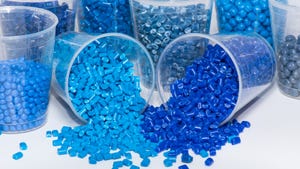The recycling of postconsumer plastic film packaging surged 116 million pounds, or 11%, in 2013 to reach a reported 1.14 billion pounds, according to a national report released on Feb. 24 at the 2015 Plastics Recycling Conference. This marks the highest annual collection of plastic film—a category that includes product wraps, bags and commercial stretch film made primarily from polyethylene (PE)—for recycling, since the survey began in 2005.
February 24, 2015
The 2013 National Postconsumer Plastic Bag & Film Recycling Report also found a 75% increase in polyethylene film collected for recycling since 2005. Moore Recycling Associates Inc., which authored the report for the American Chemistry Council's (ACC) Plastics Division, attributes the gain to a combination of increased collection and more comprehensive reporting.
The increases detailed in the report show that greater collection is taking place among small- and mid-sized businesses and that consumers are bringing more of their used flexible plastic wraps to at-store collection programs to be recycled.
"We are pleased to see such strong growth in the recycling of polyethylene wraps," said Steve Russell, Vice President of plastics for the ACC. "These increases highlight the critical role that grocers, retailers and other businesses play in collecting this valuable material."
In recent months, several major brands and retailers have started placing the Sustainable Packaging Coalition's (SPC) "store drop-off" label on their film packages to remind consumers to bring their used polyethylene wraps back to participating grocery and retail stores to be recycled. In addition, the SPC, Flexible Film Recycling Group and Association of Postconsumer Plastic Recyclers have launched the Wrap Action Recycling Program, or WRAP, which makes it easier for state and municipal governments, brands and retailers to increase awareness of opportunities to recycle used PE wraps at local stores.
Recycled PE film is used to make a range of products, including durable composite lumber for outdoor decking and fencing, home building products, lawn and garden products, crates, pipe, and film for new plastic packaging.
A separate report released on Feb. 24 found that just over one billion pounds of rigid plastics, excluding bottles (measured separately), was collected to be recycled in the United States in 2013, representing triple the amount collected since 2007 and a slight dip (1%) since 2012.
The 2013 National Postconsumer Non-Bottle Rigid Plastic Recycling Report also found a 17% annual increase in domestic processing of these postconsumer items, with 67% processed in the United States and Canada—the highest rate since the annual report was introduced in 2007.
Of the resin categories measured in the survey, high-density polyethylene (HDPE) and polypropylene (PP) showed modest increases in 2013, with HDPE making up 36% and PP making up 39% of the total one billion pounds. The primary domestic uses for these postconsumer materials include automotive parts, crates, buckets, pipe, and lawn and garden products.
An important driver of domestic processing is the growth of plastic recovery facilities, or PRFs, which purchase mixed rigid bales (typically less valuable) and separate them into segregated resins, said the ACC release.
The one-percent decrease in rigid plastics recycling is the only dip in the report's history and is largely attributable to China's stricter standards for accepting scrap imports, commonly referred to as the Green Fence, which began in 2013. According to Moore Recycling Associates, the Green Fence had a two-fold impact on markets for recycled plastics: China's tighter controls resulted in more material available for U.S. plastic processors, and U.S. recyclers have had to meet higher quality standards to sell this material domestically and abroad.
"Recyclers addressed the challenges and opportunities presented by the Green Fence, and we believe that the plastic recycling industry emerged stronger as a result," said Patty Moore, President of Moore Recycling. "Recycled plastic producers have invested in advanced separation infrastructure or taken other steps to create higher quality bales with greater yields."
About the Author(s)
You May Also Like




